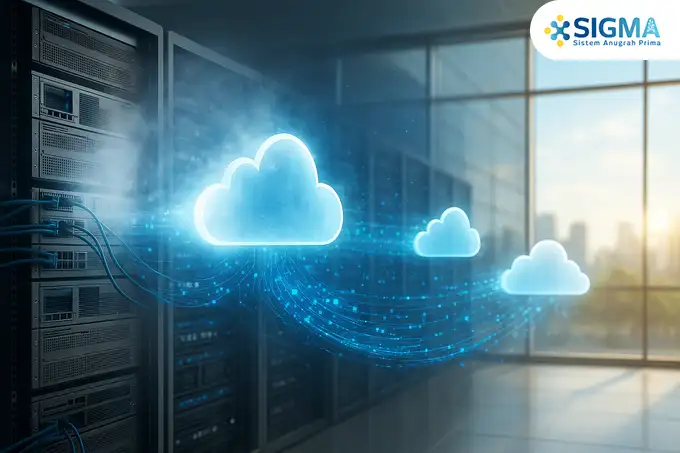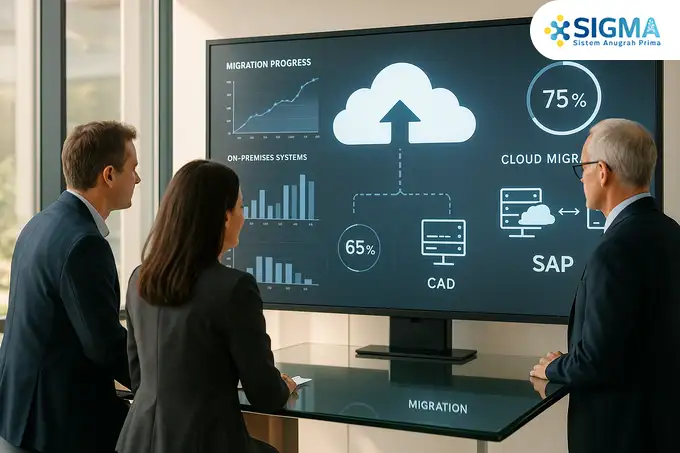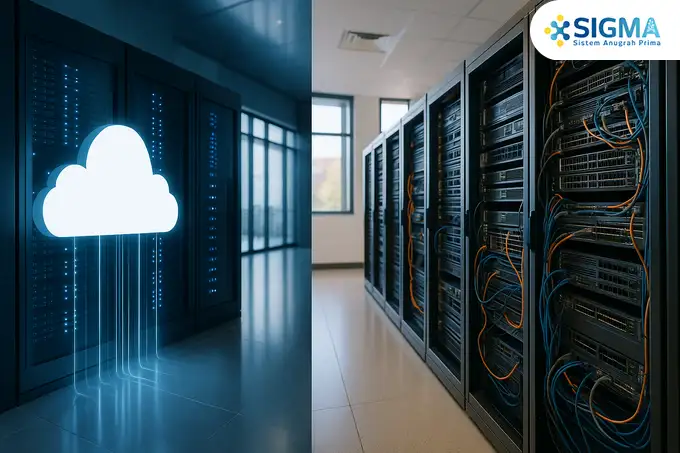Amid the relentless wave of digital transformation, modern enterprises face a pivotal decision: choosing the right Enterprise Resource Planning (ERP) infrastructure. This is not merely a technical choice but a strategic foundation that will define the trajectory of your business in the years to come.
One of the most common dilemmas lies in understanding the difference between SAP Cloud and On-Premise. The choice between these two deployment models directly impacts your investment costs, operational flexibility, scalability, and long-term growth strategy.
Selecting the wrong platform could result in wasted resources, whereas the right one can accelerate success. This article delves deeply into a side-by-side comparison of SAP Cloud and SAP On-Premise, guiding you through each aspect to help you make a decision aligned with your company’s unique needs.
What Is SAP Cloud ERP and SAP On-Premise?
Before going further, let’s clarify the fundamental definition of both models — an essential step toward evaluating their advantages and drawbacks objectively.
- SAP Cloud ERP is a software delivery model known as Software-as-a-Service (SaaS). In this model, your entire infrastructure, software, and data are hosted on servers owned by a cloud service provider (such as SAP or its partners). You access the ERP system through the internet, similar to how you use email or social media applications.
- SAP On-Premise, in contrast, follows the traditional approach — companies purchase software licenses and install them on physical servers located within their facilities. The internal IT team holds full responsibility for managing, maintaining, and securing the entire infrastructure.
To put it simply, SAP Cloud is like renting a fully furnished apartment in a modern building — you pay a monthly subscription, and the building management (SAP vendor) handles maintenance, security, and facilities.
Meanwhile, SAP On-Premise is like building and owning your own house — you have full control over its design, layout, and security, but every construction, maintenance, and repair cost is entirely yours.
Comparison Table: SAP Cloud vs On-Premise
To provide a clearer overview, below is a direct comparison between SAP Cloud and SAP On-Premise.
| Aspect | SAP Cloud ERP | SAP On-Premise |
|---|---|---|
| Deployment | Hosted on external cloud servers (SaaS model). | Hosted on internal company-owned servers. |
| Initial Cost | Low, based on a subscription model (OpEx – Operational Expenditure). | Very high, involving the purchase of hardware, servers, and licenses (CapEx – Capital Expenditure). |
| Maintenance | Fully managed by SAP or its authorized partners. | Completely the responsibility of the company’s internal IT team. |
| Scalability | Highly flexible and easily expandable in line with business growth. | Limited by existing hardware capacity; requires additional investment for upgrades. |
| Security | Managed by experts with global security standards, advanced encryption, and automatic backups. | Entirely dependent on the internal security team’s policies, expertise, and resources. |
| System Updates | Automatic, periodic, and handled by the vendor without disrupting operations. | Manual, requiring careful planning, resources, and often resulting in downtime. |
| Accessibility | Flexible, accessible anytime and anywhere with an internet connection. | Restricted, generally accessible only within the company’s internal network. |
| Implementation Time | Relatively fast, typically ranging from a few weeks to months. | Takes significantly longer, from several months to over a year. |
Deployment
Hosted on external cloud servers (SaaS model).
Hosted on internal company-owned servers.
Initial Cost
Low, based on a subscription model (OpEx – Operational Expenditure).
Very high, involving the purchase of hardware, servers, and licenses (CapEx – Capital Expenditure).
Maintenance
Fully managed by SAP or its authorized partners.
Completely the responsibility of the company’s internal IT team.
Scalability
Highly flexible and easily expandable in line with business growth.
Limited by existing hardware capacity; requires additional investment for upgrades.
Security
Managed by experts with global security standards, advanced encryption, and automatic backups.
Entirely dependent on the internal security team’s policies, expertise, and resources.
System Updates
Automatic, periodic, and handled by the vendor without disrupting operations.
Manual, requiring careful planning, resources, and often resulting in downtime.
Accessibility
Flexible, accessible anytime and anywhere with an internet connection.
Restricted, generally accessible only within the company’s internal network.
Implementation Time
Relatively fast, typically ranging from a few weeks to months.
Takes significantly longer, from several months to over a year.
Advantages of SAP Cloud ERP: Agile, Efficient, and Modern

The cloud model offers an array of advantages highly relevant to today’s dynamic business landscape:
- Low and Predictable Initial Costs: With a subscription-based (OpEx) model, companies avoid hefty upfront capital expenditures (CapEx) on servers and infrastructure. This makes the cost of SAP Cloud vs On-Premise easier to forecast and manage within operational budgets.
- Unlimited Accessibility and Mobility: Your team can access real-time business data from anywhere — whether from branch offices, home, or while traveling. This fosters collaboration and speeds up decision-making.
- Continuous Innovation with Automatic Updates: You will always run on the latest software version, complete with up-to-date features and innovations, automatically maintained by SAP. This relieves your IT team from complex manual updates.
- World-Class Data Security: Cloud providers like SAP invest heavily in cybersecurity. Your data is protected through multilayered protocols, encryption, and 24/7 threat monitoring by experts — often surpassing what internal teams can achieve.
- Flexible Scalability: As your business grows, you can easily add users or computing resources with just a few clicks. SAP Cloud ERP’s flexibility ensures your system scales seamlessly alongside your organization.
Advantages of SAP On-Premise: Complete Control and Customization
While cloud adoption continues to rise, the on-premise model still has its merits in certain scenarios:
- Total Control Over Systems and Data: Since the infrastructure is entirely under your management, you maintain full autonomy over configuration, management, and data security according to internal policies.
- Unlimited Customization: SAP On-Premise allows deep customization tailored to highly specific or complex business processes that standardized cloud solutions may not accommodate.
- Regulatory Compliance: In industries like banking, finance, or government, where data localization regulations are stringent, on-premise remains the only compliant choice.
Drawbacks of Each Model to Consider
Every solution has its trade-offs. Making a sound decision requires understanding the inherent limitations of both models.
Disadvantages of SAP Cloud:
- Limited Customization: Although flexible, it doesn’t allow the same level of deep customization as the on-premise model.
- Dependence on Internet Connectivity: System performance heavily relies on the quality and stability of your internet connection.
Disadvantages of SAP On-Premise:
- High Upfront Investment: The costs for hardware, servers, licenses, and IT personnel can be financially burdensome.
- Complex Maintenance and Upgrades: Updates must be done manually, often requiring downtime and significant planning.
- Slow and Expensive Scalability: Expanding capacity demands additional hardware purchases, a process that is both time-consuming and costly.
When Should Businesses Migrate to SAP Cloud ERP?

The question “Which is better — SAP Cloud or On-Premise?” depends heavily on context. Here are several scenarios to guide your decision:
Choose SAP Cloud if:
- Your business is experiencing rapid growth and requires a system that scales effortlessly.
- Your workforce is distributed or operating under a hybrid/remote model.
- You want to focus on core business operations and delegate technical aspects like maintenance and security to experts.
- You prefer minimizing capital expenditure (CapEx) and adopting a predictable operational expense (OpEx) model.
Stay with SAP On-Premise if:
- You operate in industries with strict regulations that prohibit off-site data storage.
- You already possess substantial IT infrastructure investments and a highly capable internal team.
- Your business processes are deeply unique and demand extensive customization not feasible in the cloud.
Conclusion: Choose What Aligns with Your Long-Term Vision
The fundamental difference between SAP Cloud and On-Premise lies in ownership, cost structure, flexibility, and control. SAP Cloud delivers agility, operational efficiency, and continuous innovation — making it ideal for modern, fast-growing enterprises.
Conversely, SAP On-Premise provides unmatched control and customization, best suited for organizations with specific operational requirements or stringent data governance.
Ultimately, there is no one-size-fits-all answer. The optimal decision depends on a comprehensive evaluation of your company’s scale, industry, resources, and strategic vision.
Ready to take the next step in transforming your business?
Whether you are considering a shift toward a more agile platform or seeking expert consultation to assess your options, don’t navigate this decision alone.
Reach out to PT. Sistem Anugrah Prima (SIGMA) today. As an official SAP partner in Indonesia, our expert team is ready to analyze your business needs, design an implementation roadmap, and ensure a seamless, successful transition to SAP Cloud ERP. Let’s achieve greater efficiency and sustainable growth together with SIGMA!
Frequently Asked Questions – SAP Cloud vs On-Premise
Is SAP Cloud more affordable than On-Premise?
In the short term, yes — SAP Cloud requires no upfront purchase of servers or perpetual licenses, making it far more cost-effective to start. However, long-term cost analysis should consider the Total Cost of Ownership (TCO). While On-Premise involves significant initial capital expenditure, it does not require ongoing subscription payments. Cloud models, on the other hand, operate under predictable recurring fees that typically remain lower overall due to reduced maintenance, upgrade, and staffing costs.
Is data security stronger in the Cloud?
Contrary to common misconceptions, Cloud data security is often superior. Leading providers like SAP employ advanced multi-layered encryption, 24/7 intrusion monitoring, and compliance with global cybersecurity standards such as ISO 27001. These extensive measures frequently surpass what most internal IT teams can achieve, making SAP Cloud security a reliable choice for modern enterprises.
Can SAP On-Premise be upgraded to Cloud without data loss?
Yes, absolutely. This process, known as Cloud Migration, enables companies to move from their existing On-Premise infrastructure to SAP Cloud ERP while retaining full data integrity. With the right planning and guidance from an experienced SAP implementation partner like SIGMA, the transition can be completed smoothly and securely.
Which model has faster implementation?
SAP Cloud ERP implementations are notably faster. Since infrastructure and system environments are preconfigured, the focus lies primarily on customization and integration — not infrastructure setup. Most deployments can be finalized in weeks, whereas On-Premise systems may require several months to over a year due to hardware procurement, system testing, and internal coordination.
Beyond Technology: Strategic Implications of Your Choice
Choosing between SAP Cloud and On-Premise extends beyond infrastructure preferences — it represents a decision about how your organization will evolve in the digital era.
SAP Cloud offers agility and scalability essential for growth-driven companies. It enables continuous innovation, faster decision-making, and operational efficiency — ideal for businesses that aim to adapt quickly to changing markets.
In contrast, SAP On-Premise suits organizations prioritizing autonomy, in-house control, and deep system customization — especially those bound by stringent compliance or operating in sensitive sectors like finance, defense, or government.
How SIGMA Helps You Navigate the Transition
PT. Sistem Anugrah Prima (SIGMA), an official SAP Gold Partner in Indonesia, has years of proven experience helping companies transition seamlessly between On-Premise and Cloud environments.
Our approach includes:
- Comprehensive Business Assessment: We evaluate your current system landscape, business objectives, and growth plans to recommend the optimal SAP architecture.
- End-to-End Implementation: From planning to post-launch optimization, we handle deployment, data migration, and integration with minimal disruption.
- Ongoing Support & Optimization: Our certified consultants continuously monitor and enhance your ERP performance for maximum ROI.
Final Takeaway
Whether you choose SAP Cloud ERP for its scalability and innovation, or SAP On-Premise for its control and customization, the ultimate goal remains the same — empowering your organization to operate smarter, faster, and more efficiently.
Make an informed decision backed by insight, expertise, and real-world experience.
Let SIGMA guide your journey toward ERP excellence.
Contact us today to schedule a consultation and begin your transformation with SAP Business One or SAP Cloud ERP. Together, we’ll build a foundation for sustainable growth and digital success.



